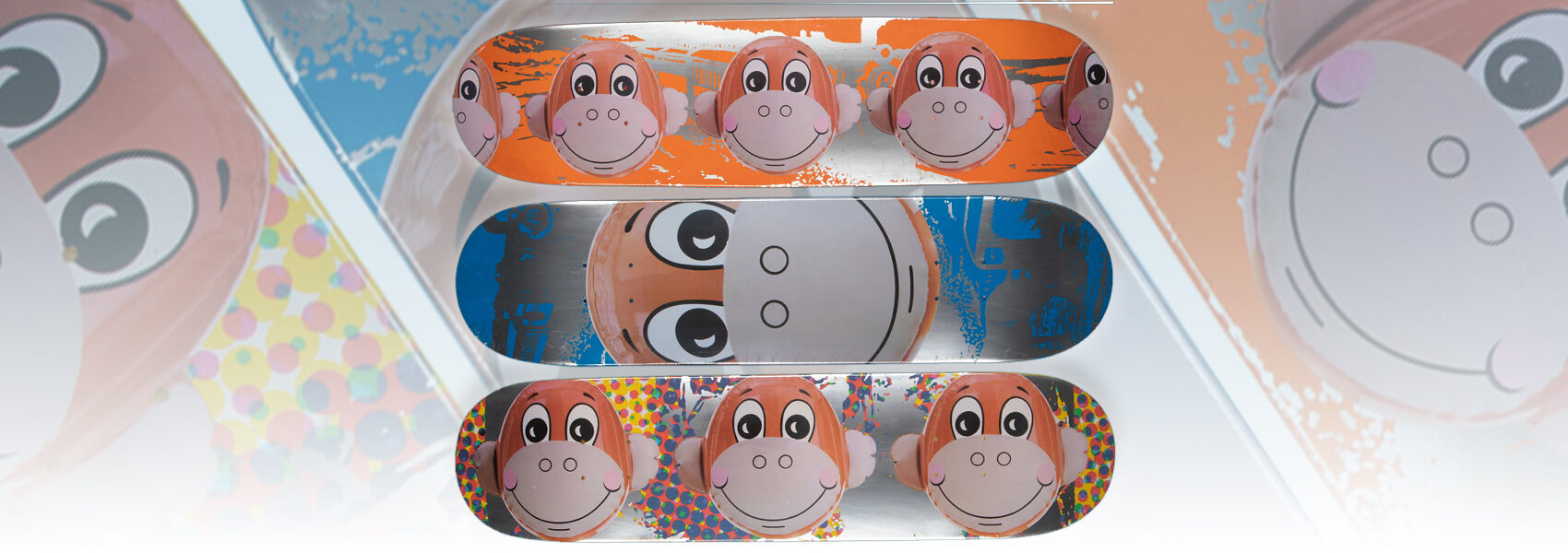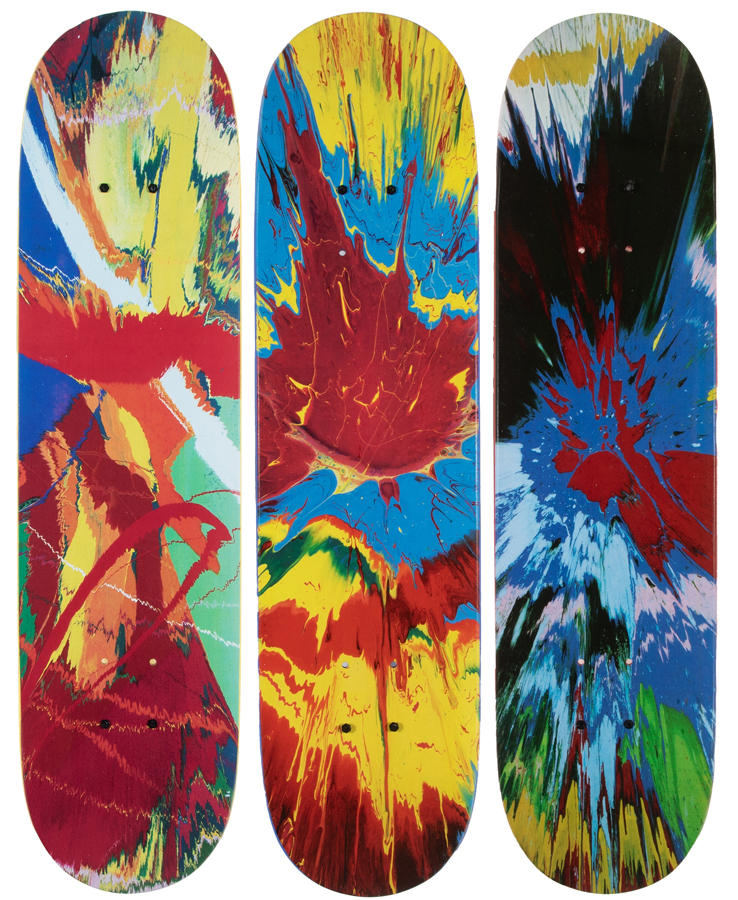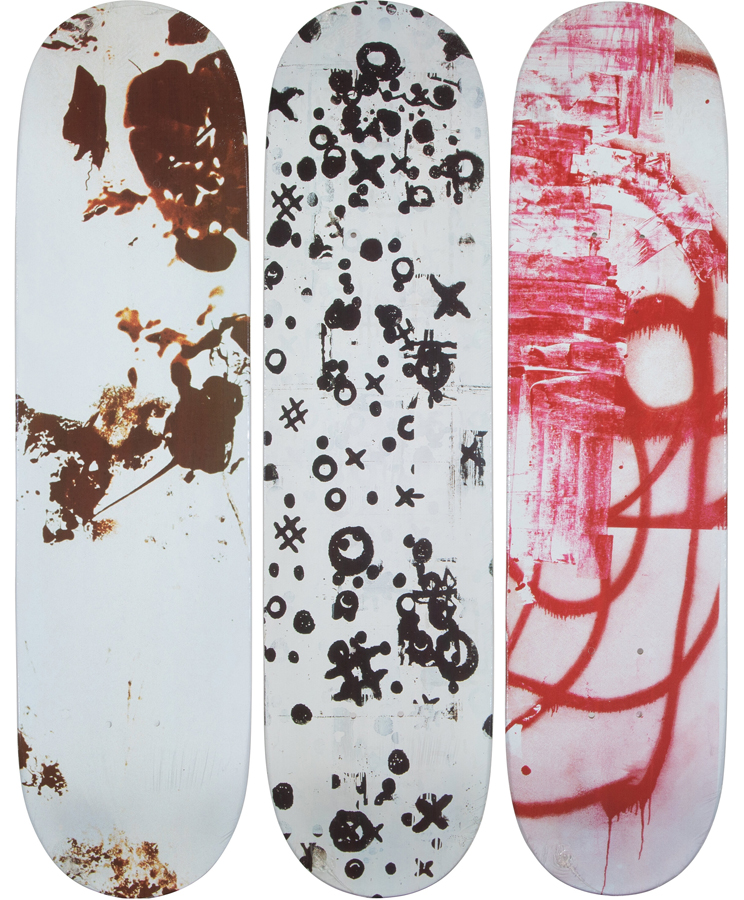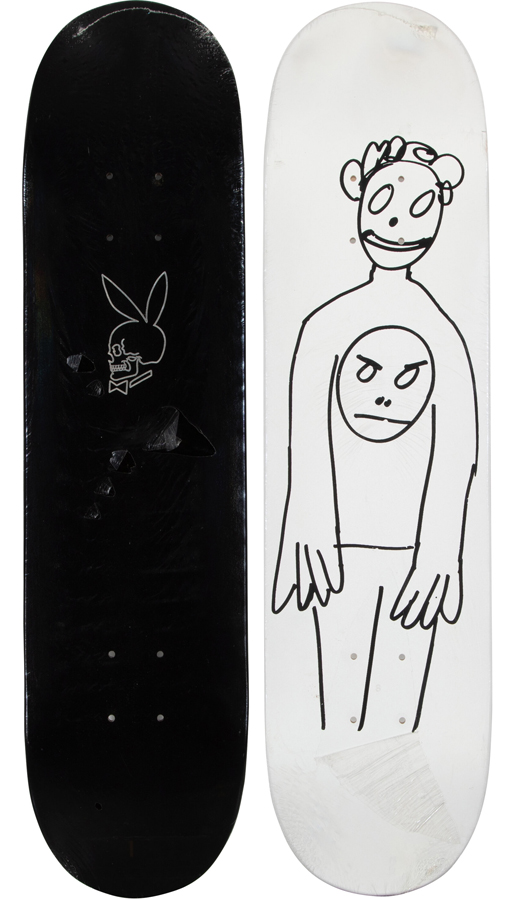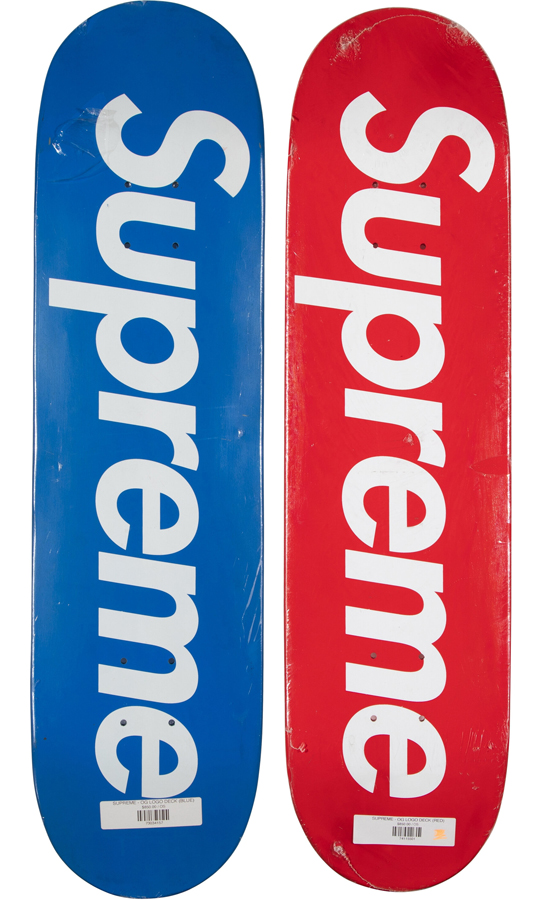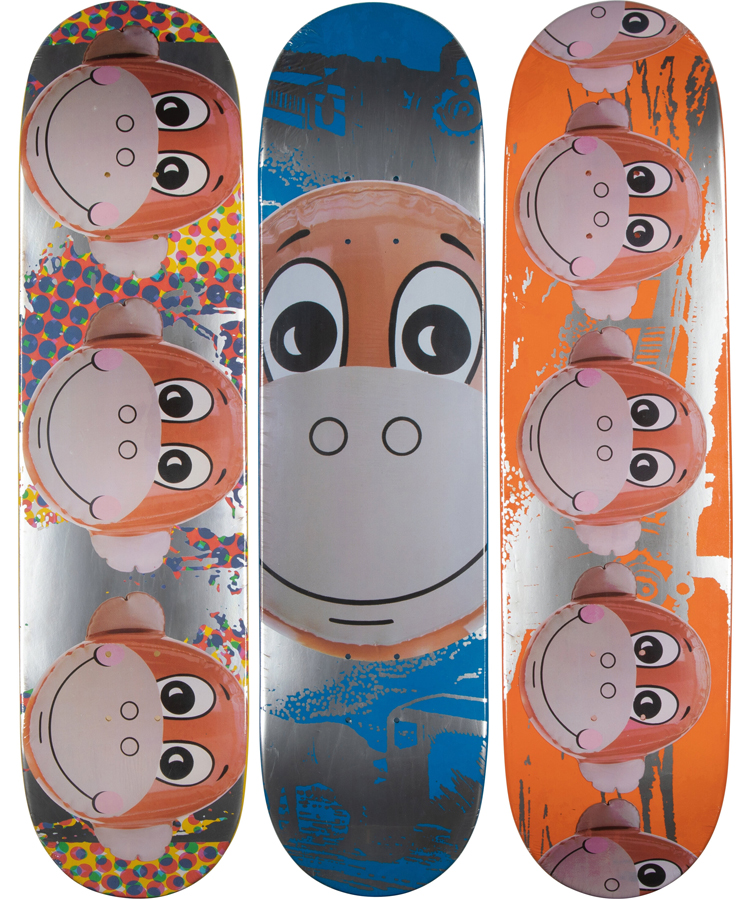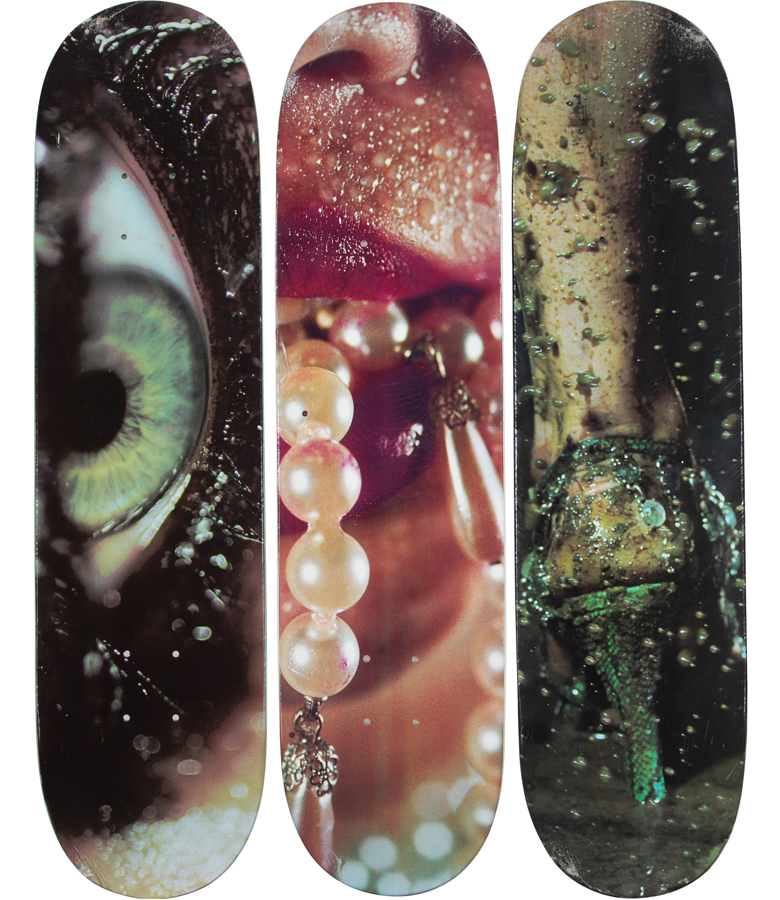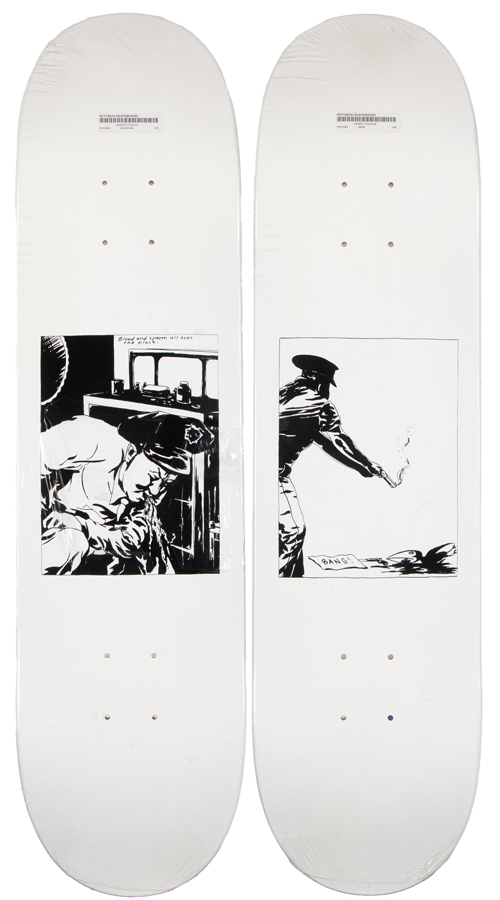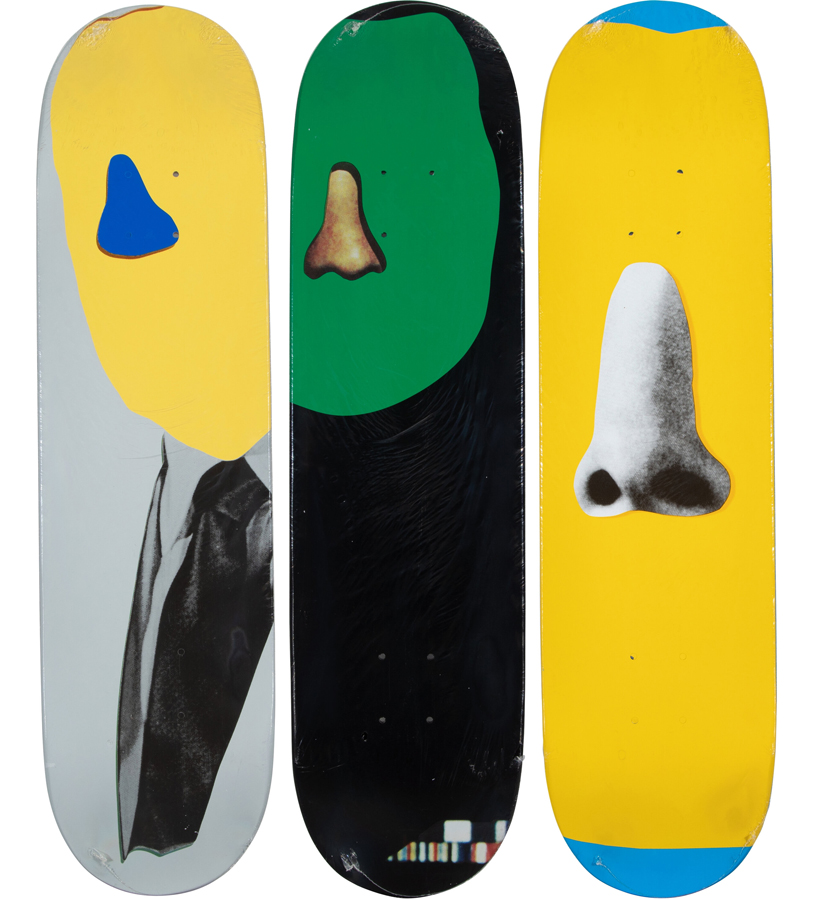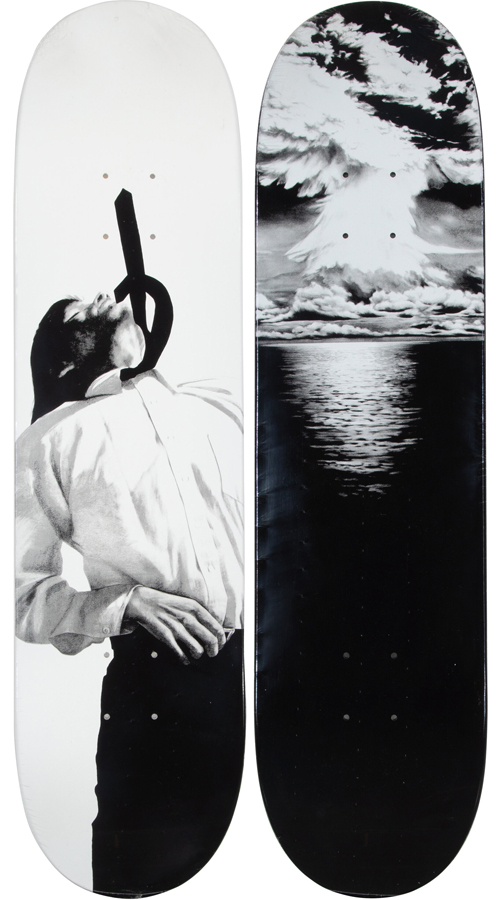THE SKATE BRAND FUSES HIGH AND LOW IN ITS ICONIC SERIES OF COLLABORATIONS WITH THE WORLD’S MOST FAMOUS – AND TRANSGRESSIVE – ARTISTS
By Christina Rees
In 1995, photographer and director Larry Clark’s infamous movie Kids introduced the world to a scrappy and resourceful downtown youth culture centered on teenage urban skateboarding – and the scene’s attendant drugs and sex – that it may not have been ready for. But the skate punks of Washington Square Park, as written for Kids by the then-unknown enfant terrible Harmony Korine, were not new to New York City. They not only had a stomping ground. They had an established attitude and aesthetic that the previous year had been synthesized by a new storefront and streetwear brand: Supreme. The employees at 274 Lafayette Street played extras in Kids (Korine, still a teenager at the time, lived in the neighborhood), and outside the shop young skate punks and would-be skaters stood in line to wait for weekly “drops.” Supreme’s English expat purveyor, the Gen-Xer James Jebbia, tapped into and then reified an entire psychology of hype and grail that continues to this day.
Supreme X Damien Hirst ‘Spin (set of three),’ 2009. Screenprints in colors on skate decks. 32 x 8 inches (81.3 x 20.3 cm) (each).
While Supreme didn’t even launch a website until 2006, within years of its opening, the brand started rolling into a slow-burn, growing global appreciation for young discerning skaters and collectors. The brand continued that roll by initiating high-profile collaborations with artists, designers and other pop-culture figures – transgression being Supreme’s operative philosophy alongside the stamp of high fashion (the brand is as closely associated with Louis Vuitton as it is artists like Richard Prince and Larry Clark) – and opened stores in Tokyo, London and Paris. The protected status of underground cool can’t stay underground forever, especially not in the internet age.
Supreme X Christopher Wool ‘Skate Decks (triptych),’ 2008. Offset lithographs in colors on skate decks. 32 x 8 inches (81.3 x 20.3 cm) (each). Edition of 500.
Supreme had launched as a clothing and accessories outfit but by 1998 was producing skateboard decks – the earliest emblazoned with Supreme’s now-iconic logo, a nod to the font style of the anti-consumerist artist Barbara Kruger. As the brand found its legs via notable collaborations with artists, the decks became as covetable and collectible as they were functional. Supreme’s decks have a good reputation with skateboarders who actually take them to the pavement, but a sizable market for the decks never put wheels on them at all: They display them, like the limited-edition artworks they are, on the wall or in glass cases.
Supreme X Richard Prince ‘Skull Bunny; Hipper White (two works),’ 2007. Offset lithograph in colors and laser etching on skate decks. 32 x 8 inches (81.3 x 20.3 cm) (each).
The brand’s choice of artists for these deck collaborations reflects a sensibility that echoes the earliest days of Vice’s print magazine, the downtown New York dirtbag-scene works of Dash Snow and Ryan McGinness, as well as the Urban Artists who defined an era, like Rammellzee and Dondi White. Supreme’s deck history zigzags from the unexpected (Margaret Keane) to pure pop culture (one deck features a scene from the movie Gremlins; another is a found photo of Tupac Shakur) to collabs with fashion design houses (Maison Margiela, Burberry). Supreme’s capture of the very essence of high-low is one of its most remarkable contributions to an American aesthetic that travels well and holds its value across decades.
Supreme ‘Logo Deck (two works),’ 2007. Screenprints in colors on skate decks. 32 x 8 inches (81.3 x 20.3 cm) (each).
On February 20, Heritage celebrates Supreme’s 30th anniversary with a tight auction that showcases some of the brand’s most notable collaborations and includes a handful of its most iconic skateboard decks. The selection is a distillation of Supreme’s history and taste, with big names like Damien Hirst and Jeff Koons; canny choices of artists heavily associated with a glorious and gritty downtown New York history (Robert Longo, Marilyn Minter); and collabs with artists known for stirring up controversy (Jake and Dinos Chapman, Richard Prince, the aforementioned McGinness). The everywhere-all-at-once master collaborator Takashi Murakami is here, as well as the tough-and-cool artists who, when you pair them in your head with Supreme, you think: Yes, that makes total sense: Raymond Pettibon, John Baldessari and Christopher Wool.
What follows are some of the choice artist collaboration skateboard decks in Heritage’s February 20 event. Each of these would pass the smell test of any established art critic or collector, as well as satisfy the visual acumen of Supreme’s scrappy real-life skaters (though these categories are not mutually exclusive).
Supreme X Jeff Koons ‘Monkey Train (triptych),’ 2006. Offset lithographs in colors on skate decks. 32 x 8 inches (81.3 x 20.3 cm) (each). Edition of 500.
Supreme X Jeff Koons
Jeff Koons, the art world’s most prominent bad boy Pop Artist (a sort of Patrick Bateman-esque figure who is as inscrutable in person as his work is significant), collaborated with Supreme in 2006 and called the work Monkey Train. The offset lithograph decks lean into a repeat motif cartoon; shimmery metallics; flat, bright colors; and Ben-Day dots – thus pulling references to Warhol, Lichtenstein and, of course, Koons himself. Two sets of the Supreme-Koons collab are on offer: one a triptych and one a twofer from an edition of 500.
Supreme X Marilyn Minter ‘Lips With Pearls; The Glitter Eye; The Shit Kicker Heels (triptych),’ 2008. Screenprints in colors on skate decks. 32 x 8 inches (81.3 x 20.3 cm) (each).
Supreme X Marilyn Minter
Marilyn Minter is rightfully beloved for smashing together the tropes of high-fashion photography with a darkly sexy and critical eye for capitalist exploitation. Her claustrophobic images are glossy wet with menace and seduction. Her 2008 collab with Supreme includes this triptych titled, aptly, Lips With Pearls; The Glitter Eye; The Shit Kicker Heels. It is instantly recognizable as Minter in her prime. There is no fat on these images.
Supreme X Raymond Pettibon ‘Bang and Blood and Sperm (two works),’ 2014. Screenprints on skate decks. 32 x 8 inches (81.3 x 20.3 cm) (each).
Supreme X Raymond Pettibon
The work of Raymond Pettibon, whose name is synonymous with the 1980s Southern California punk scene, has never lost its cool, and as the art world careens from one trend to another, his legacy becomes ever more solidified. His black-on-white drawings – loose and rangy and often interrupted with savage text – defined an era soundtracked by Black Flag, Mike Watt and Sonic Youth. Pettibon is an ongoing art-world darling from the underground, and his 2014 work with Supreme includes this duo of screenprinted decks titled Bang and Blood and Sperm. Like much of his work, these images look as though they’re panels ripped from a dirty and long-forgotten amateur comic book.
Supreme X John Baldessari ‘Untitled (triptych),’ 2010. Screenprints in colors on skate decks. 32 x 8 inches (81.3 x 20.3 cm) (each).
Supreme X John Baldessari
John Baldessari, who died in 2020 at age 88, is another artist heavily associated with Southern California, although unlike Pettibon, he’s a rigorous conceptual artist whose work sits at the tip-top of America’s contribution to the category. Baldessari’s photography and found-image collage work, along with his teaching legacy – for three decades, and most famously at CalArts, where he carved out a sharp and critical philosophy that has influenced countless artists – are invaluable contributions to contemporary art history. His 2010 collaboration with Supreme includes this untitled triptych that features one of Baldessari’s enduring motifs: a disembodied nose floating in flattened, graphic and collaged space.
Supreme X Robert Longo ‘Men in the Cities; Explosion (two works),’ 2011. Offset lithographs in colors on skate decks. 32 x 8 inches (81.3 x 20.3 cm) (each).
Supreme X Robert Longo
New York’s beloved Robert Longo made his name with his remarkable 1977-1983 series Men in the Cities – exacting and monumental graphite drawings of yuppies who look as though they are flailing and seizing in either agony or ecstasy. It is perhaps the most definitive work of New York’s Pictures Generation, and it captures an entire ethos of the go-go 1980s – cocaine, Wall Street, an endless and rapacious treadmill of work, work, work. In its 2011 collaboration with Longo, Supreme rightly features images from the highly graphic series, along with images that reference Longo’s acclaimed and later Sickness of Reason series (images of atomic bomb explosions). This lot, offset lithographs titled Men in the Cities; Explosion (two works), features one image from each.
 CHRISTINA REES is a staff writer at Intelligent Collector.
CHRISTINA REES is a staff writer at Intelligent Collector.

